Kitchen Project #17: Rhubarb custard crumble cake
With love and gratitude to my mum for today's subject <3
Hello,
Welcome to another edition of Kitchen Projects. This week we’re embarking on a topic that has been on my mind for years: Crumbs.
Although that might not seem the most exotic of topics, there’s a lot of lessons to be learned by exploring those ratios of butter/sugar/fat! Of course, you need to put something WITH the perfect crumbs, so this week they will sit proudly on my mum’s fave cake: Rhubarb & Custard cake.
On that note, I’d like to take a moment to share a message of love, solidarity and support to all women.
This week began with International Women’s Day and ends on Mother’s Day here in the UK, two days where we celebrate all of the women in our lives. But this week has also been marked an absolutely horrendous tragedy that has moved us all.
I know how unsettled you might be feeling… because I feel it too. The violence that women experience is totally senseless. We should not have to fear walking home. We should not be forced to deal with unwanted daily interactions or attention. We deserve to live our lives peacefully.
Please know I am thinking of you all and am here to support you in any way that I can - please don’t hesitate to write to me if you ever want to chat.
Love,
Nicola
PS. No playlist this week - instead here’s a link to a brilliant podcast series ‘Hidden Homicides’ which dives deeply into stories of domestic abuse and the systematic failings of the police investigating the cases. It is a vital listen. It happens to be edited by an incredible woman in my life - Basia Cummings (who, btw, edits this newsletter.) Thank you Basia <3
---
Rhubarb + Custard = Happiness
The world of crumb cakes is a world I am happy to live in.
As I am currently living with my parents as we wait for our next place, and since today is Mother’s Day and ALL about my wonderful mum (quick s/o to mum, thanks for always reading my newsletter mum), I asked her what she’d like me to make for Kitchen Projects.
The answer? Rhubarb and custard cake, please!
You’re the boss, mum.
Now, this is one of those cakes which is basically guaranteed joy – ultra soft sour cream cake at the base, followed by vanilla creme pat and poached rhubarb. It’s finished with a crumb of dreams. It’s a whole dessert in one mouthful. It’s got real multitasking energy – in one bite you get a tender crumbed cake, smooth custard, bright rhubarb and crunchy crumb.
It’s one of those Kitchen Projects where I am asking rather a lot of you… Yes, you have to make the rhubarb AND the pastry cream in advance before you can even begin the cake and crumb layer… but I hope you trust me when I say it is absolutely worth it.
Crumbs the word
(sorry I couldn’t resist that)
Although we’ll talk a bit about all the elements, today is really about crumbs. Crumbs are pretty much a pastry chef’s best friend. Panna cotta looking a bit… er… soft? Chuck some crumbs on it! That chocolate cremeux looking a bit one dimensional? CRUMBS! Plate looking a bit empty? That’s right… The answer is crumbs. I usually have a small tub full somewhere in the kitchen to deploy at will.
Crumbs aka streusel aka crumble is irresistible. It harks back to a simple time of school dinners, giving me grown-up fruit crumble and tinned custard feels.
In the US, there’s a whole category of cakes called “Coffee cake” and they generally don’t include coffee. I know we’re used to a coffee and walnut classic here, but don’t let the confusing name put you off. It’s the accompaniment to coffee, not the flavour itself, that gives it its name. It’s usually a soft cake topped with LOTS of crumb.
In the UK, we just add on an ‘le’ and call these crumble cakes. In Germany, they’re known as streuselkuchen and the US versions seem to be styled much more on these – there is pretty much a 1:1 ratio of crumb to cake. Although I LOVE the mega crumb energy, that’s for another day. Today, we’ll just take a smattering of crunchy bits to bring the rhubarb custard to life.
Getting crumbs right is more critical than you think. Too much butter and they fall totally flat and sad. Too little and the crumb is hard, flavourless and lacks joy.
The holy trinity: butter + sugar + flour
Butter, sugar and flour are the backbone of the pastry kitchen. Eggs come in fourth. But these three really dominate the scene. A simple crumb or streusel is a balanced combination of these three ingredients. There are a few tests I want to take you through today.
Variable 1: the formulation
I have to be honest with you, every time I have to make a crumb I kind of lose my mind. Although it’s such a simple concept, I freak out about the ratio and don’t know where to turn. Today, I’m ending the reign of crumb fear! Perhaps I’m the only one out there who has trouble with this. But in any case, I hope there’s some lessons to be learned.
According to most traditional streusel recipes, a 1:1:2 ratio of butter:sugar:flour seems popular. This is at odds with traditional apple crumble, which – according to my googling – seems to be all over the shop. Anywhere from very little sugar, to almost double butter to sugar, to equal butter flour and butter. It’s a minefield.
So what is the perfect crumb ratio? Let’s give it a go. Although I’m pretty sure some of these ratios aren’t going to be appropriate, I want to demonstrate what the relationship between these three ingredients looks like. Hopefully this will give you some insight into how recipes are balanced
Let’s run some tests
For these tests, I decided to use light brown sugar. Mainly because I love the flavour. It’s worth remembering that brown sugar contains molasses and has a higher moisture content, which translates into tender baked goods like cakes or banana breads. For ease, I also used the melted butter method, where I mix all the dried ingredients and then stir in melted butter until clumps form.
All the tests were baked in a 170c until golden.
Test A:
Ratio is 1 : 0.75 : 1
Equal flour/sugar, less butterPre baking, test A felt quite oily - surprising given it had one of the smaller percentages of butter compared to the other ingredients. That being said, the brown sugar was definitely dominant and the moisture from that was clearly making an impact. On baking, the crumbs spread immediately into each other and it baked as a single mass – uh oh. Definitely would have been gutted if I’d put this on top of a cake thinking it would stay separate! The final baked result was quite crunchy, a little chewy and very sweet. It was actually quite delicious – much more like a sticky crunchy biscuit garnish.
Test B:
1:1:1
Equal butter, sugar and flourThis was hella oily before baking. As soon as it went into the oven it melted into an ultra crispy but kind of sticky biscuit. It totally lost any crumb definition and what was left was a gigantic lacy biscuit. Now, this isn’t surprising given the ratio of ingredients. Butter, in a hot oven, will evaporate and leave behind little holes. As the ingredients were equally dominant, there was not enough ‘mass’ there to keep things together. This test lived and died on its butter content. I salute it. Totally inappropriate for cake toppings but quite cute as a solo biscuit, although the sugar level does make them a bit teeth-sticky.
Test C *The absolute winner*
1:2:3
Low sugar, medium butter, high flourFinally, a crumb that didn’t immediately freak out when hitting the oven! Unsurprisingly, the higher flour content is the hero here, combined with the much lower sugar. Sugar, as we know, doesn’t just contribute to sweetness. It is actually supposed to keep bakes soft and moist (think cookies, brownies). That being said, it can also make things ultra crunchy in the right formulation! For a crumb, the only real role sugar needs to play is sweetness. The fat and the flour is doing most of the lifting (think pie crusts, pastry with little sugar that are still ultra flaky) so actually, the lower sugar here is PERFECT. DEFINITELY my favourite so far as it stays quite chunky.
Test D
1:1:2
The CLASSIC (Wikipedia says so) one with equal sugar and butter, double flour
This is a very fine, quite classic looking crumb. It definitely has a finer texture than the others and immediately mixes/crumbs to very small pieces. As it bakes, it retains its shape and doesn’t move much – you’re left with a bunch of crunchy pebbles, with a final texture similar to that of granola. I like it. But the problem is that it is the sort of crumb that if you inhale too quickly then you’re in for some trouble.
Variable 2: melted vs. cold butter
When it comes to making crumbs, you’ve usually got two camps. The melted butter v. cold butter gangs. But which is better? I decided to find out.
There are articles questioning ‘why did my crumb go flat?’ or ‘why did it melt so much?’ and although the authors nobly try to blame butter temperature or lack of resting, it’s almost certainly down to an inappropriate formulation.
I tested the exact same formulations as above however this time I used cold butter and I crumbed it into the dries
The result? EXACTLY. THE. SAME. WHAT! *faints*. See:
This kind of shook me honestly. But now my mind is at rest. Although melted butter is going to make a difference in some things (I mean, you are literally changing the structure of the product so you can’t expect it to behave the same and – of course – melted butter has no air holding capabilities so you’re never going to make something fluffy with it) but for crumbs? Literally no discernible difference. Not in appearance, not in taste.
Nigel Slater, a perma hero, suggests adding a little water to his crumbs to make them clump together for a more interesting texture. This, I think, would work on test ‘D’ (the 1:1:2 ratio) but isn’t necessary for my favourite test ‘C’, as they clump just fine on their own. However, I think it’s smart. So if you are ever making a recipe and your crumb is coming up a bit fine, look to Nigel.
Variations on the theme
Now that the ratio is sorted, it’s time to play around with the ingredients. Want to add oats? Go for it! Got spices on the mind? You can add those, too. Ground almonds work really well in crumbs too. Zest also excels.
Milk Bar, the American dessert and bakery chain, have a fantastic industry-leading take on their milk crumb: the initial ratio is in the classic 1:1:2 range. Once it is baked, the crumb is broken up and coated in chocolate and more milk powder, creating clumpy crumb heaven. It’s a technique you can apply to anything – I’ve made a fantastic dark chocolate crumb in the Milk Bar fashion. Here’s a link to the original recipe so you can give it a go, too.
So, how many crumbs?
Let’s be honest, we all want more crumbs. But what are the trade-offs? By totally covering the top of the cake in crumbs, you do make it rather hard for the rest of the cake to bake. By the time the heat has penetrated past the crumb fortress (which takes forever) the rest of the cake tends to over-bake.
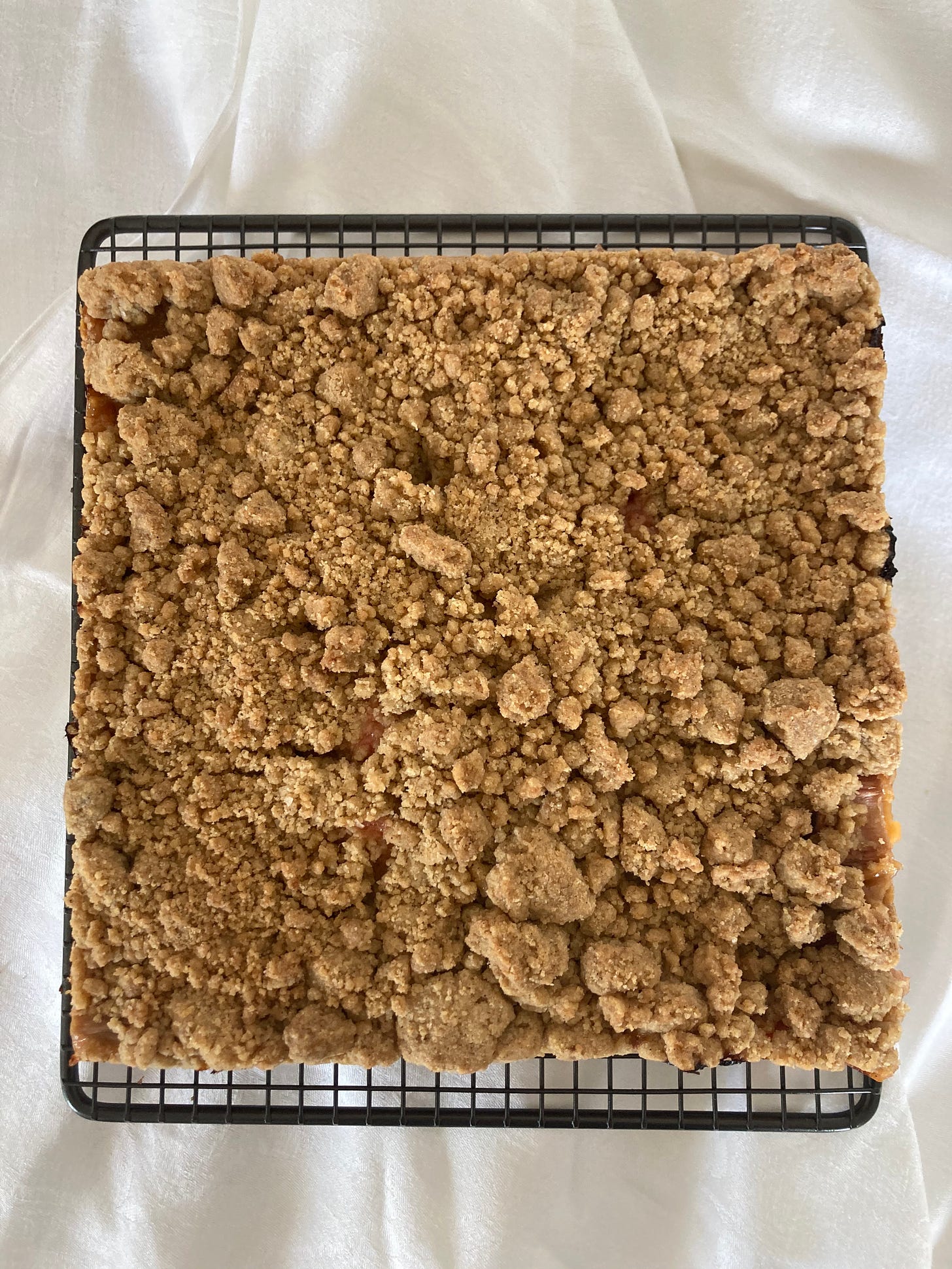
I tried it with the full crumb top method and it took 75 mins to bake through, compared to the 50-ish minutes when the crumbs were scattered. Although I loved the additional crumbs, I hated how ‘overbaked’ the rest had to be. Life is such a compromise. You gotta give your cake mixture room to BREATHE!
The rest of the recipe: cake
Sour cream is such a wonderful addition to cake recipes. It adds tang, body and fat to a crumb. The result is an extremely lush and moist cake that brings any recipe up to 11. Although sour cream seems to be used quite a lot in US recipes, I don’t see it as much in the UK. Until I became a pastry chef (and every place I worked used Nigella’s Guinness cake recipe in some form, which ft. sour cream to activate the bicarb), the only times I’d come across it were during jacket potato lunches or wild teenage nacho-eating movie nights, the latter probably squeezed from a bottle branded Old El Paso.
Well, times are changing! If you’ve never reached for the sour cream then I think this recipe will change your mind. It is genuinely the softest cake I’ve ever made. The brown sugar also adds wonderful softness as well as a complexity of flavour.
Got yoghurt? Use it. But only if it’s the thick stuff. I’m open to hearing your favourite brands but I love the Fage brand. Yoghurt and sour cream differ at the source – simply put, yoghurt is cultured milk while sour cream is cultured cream. So, you’re not going to benefit from the mouthfeel or additional unctuousness that the fat will bring, but you will still get a beautifully soft fluffy cake.
The rest of the recipe: pastry cream
You know how I said that crumbs are a pastry chef’s best friend earlier? Well, our second best friend is pastry cream. I know we’ve covered it a little bit in the past and I promise that one day I’ll do a big breakdown on the stuff, but for today I’ll share my tried and tested formulation.
Pastry cream, fortified with starch, will not break down into a runny mess in the oven. For this cake to really sing, we want to create a custardy mattress for the rhubarb to snuggle into. Pastry cream is perfect here.
I’ve tried assembling this cake several ways: I’ve spread pastry cream all across the top of the cake batter and I’ve blobbed it on. The best way? Blobs! I really prefer the generous blobs method because the custard is a bit more uneven which makes for very fun eating. Also, if you spread pastry cream all across the top, it takes forever to bake and by the time the middle is cooked, the edges are overcooked. So even though the blob method gives you good coverage, there’s a little more room for the cake to have its own groove.
Rhubarb
Guys, I’ve asked you to roast rhubarb quite a lot recently, haven’t I? Well, ‘tis the season after all. This cake is absolutely magical with peaches, pears or other lovely things. But rhubarb is irresistible at the moment and well, my mum asked. So take it up with her.
Perhaps you’re thinking: do I really need to roast the rhubarb if it’s going into the oven for 45 mins as part of a cake? The answer is no! However raw rhubarb is kind of intense and you can’t be *sure* of what’s going to happen. Given the sweet crumb custard and cake, you might be up for handling the sourness but I personally like to give the rhubarb a little lift before it joins the rest of the gang, plus you get to remain in total control. Hurrah
Alright, let’s make it!
Rhubarb & custard cake with perfect crumbs
Using an 8 x 8 inch square tin but an 8inch round would be lovely too
Ingredients
Sour cream cake
120g butter
60g sugar
60g light brown sugar
2 eggs
155g plain flour*
3g baking soda
2g baking powder
¼ tsp salt
120g sour cream
*self-raising works great here, too.
Pastry cream
250g milk
60 sugar
3 egg yolks
20g cornflour
Rhubarb
300g rhubarb
30g sugar
30g water or orange juice
1/2 orange zested
The perfect crumb (1:2:3)
50g sugar
100g butter
150g flour
½ - ¾ tsp salt, depending on your tolerance (I like salty!)
1 tsp ginger
1/2 tsp cinnamon
Method
The day before (or at least a few hours before):
Rhubarb method
Pre-heat oven to 170c. Roast the rhubarb until slightly tender with the zest, sugar and water. Leave to cool overnight for the best pink colour. If you don’t mind about that too much then you can use it right away. As above, you can use the rhubarb raw but it can be a bit of a guessing game on the final flavour. I am a control freak though
Pastry cream method
Make the pastry cream: heat milk on the stove until simmering. Whisk egg yolks with cornflour and sugar. Once milk is bubbling, pour a little over the yolks to temper and then return the whole mixture to the stove. Cook – whisking all the time – until the mixture is thick and bubbling
The day of:
Crumb method
First make the crumb: Stir together flour, salt, sugars and spices. Melt the butter and then pour over the top. Using a fork, agitate the mixture until it forms uneven crumbs. Set aside. You can actually do this the night before if you like, too
Cake method
To make the cake: cream butter and sugar together for 2-3 mins until light. You don’t need to go ultra white and fluffy here
Next, emulsify in the eggs. Now, due to the ratio between butter and eggs, it WILL probably look (and be) split. But you don’t need to worry. It will come back together later and this is an unfussy cake so please don’t lose any sleep on it
Then stir through sifted flour and raising agents
Finally stir through the sour cream - you’re now ready to assemble your cake
Assembly
Pre-heat oven to 170c
Line a cake tin with a ‘tall’ collar – this means you can put extra crumbs on top. I use a 9 x 9 square tin but you could use an 8inch deep cake tin. Most tins will work for this to be honest.
Spread the cake evenly on the base
You’ve got two options for the next step - you can either spread the custard smooth over the top of the cake layer or dot with generous blobs. Like I said earlier, I think blobs is the way forward
Place rhubarb all over the top, quite evenly
Finally, scatter generously with the crumb, making sure there is still space for things to peek out
Bake for 45-55 mins. It’s ready when there’s only the slightest hint of the wobble in the middle
Allow to cool for at least an hour or two– otherwise it’s impossible to cut. When it’s finally feeling stable, divide into squares. Enjoy! My dad added extra ice cream






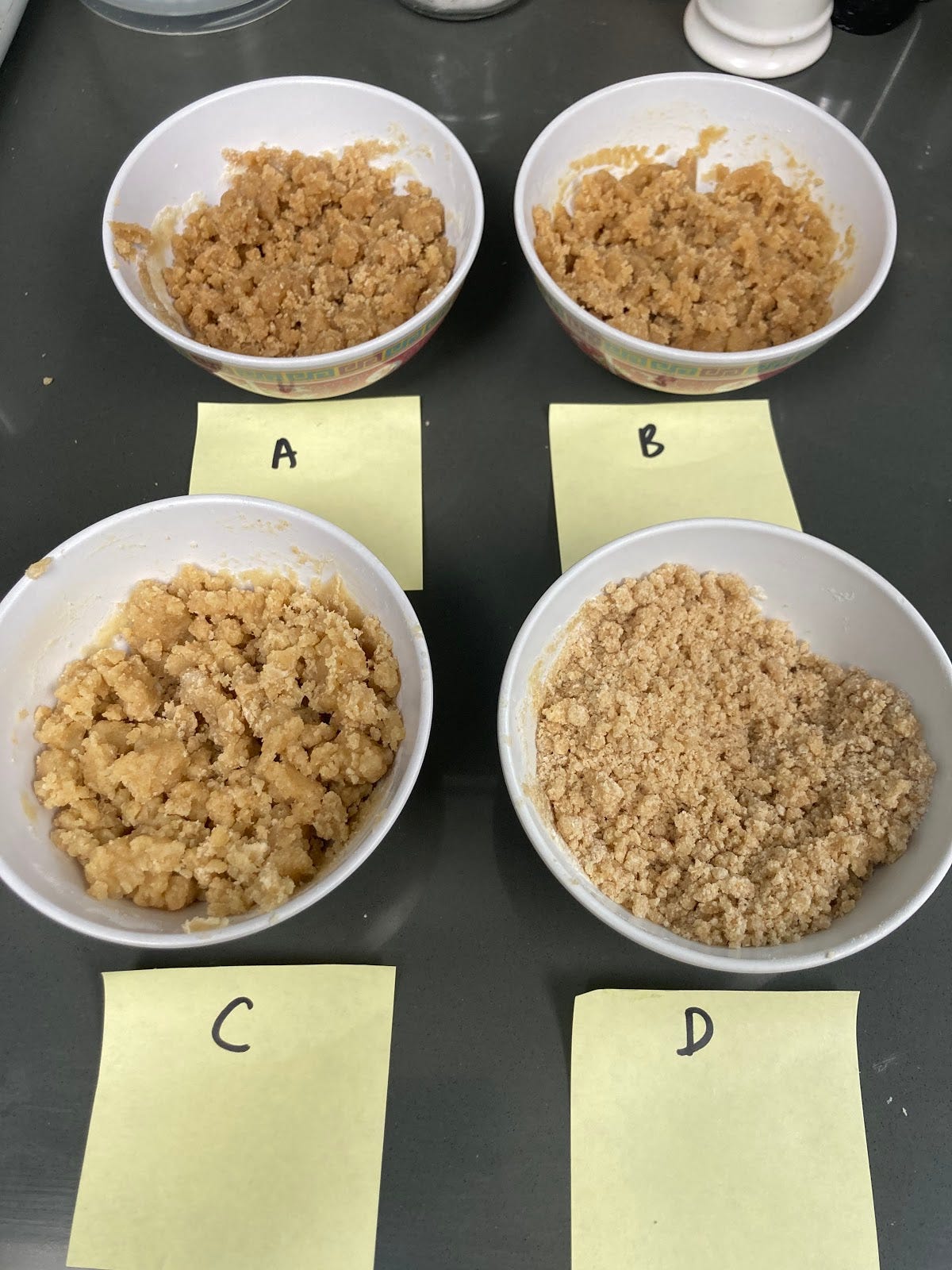
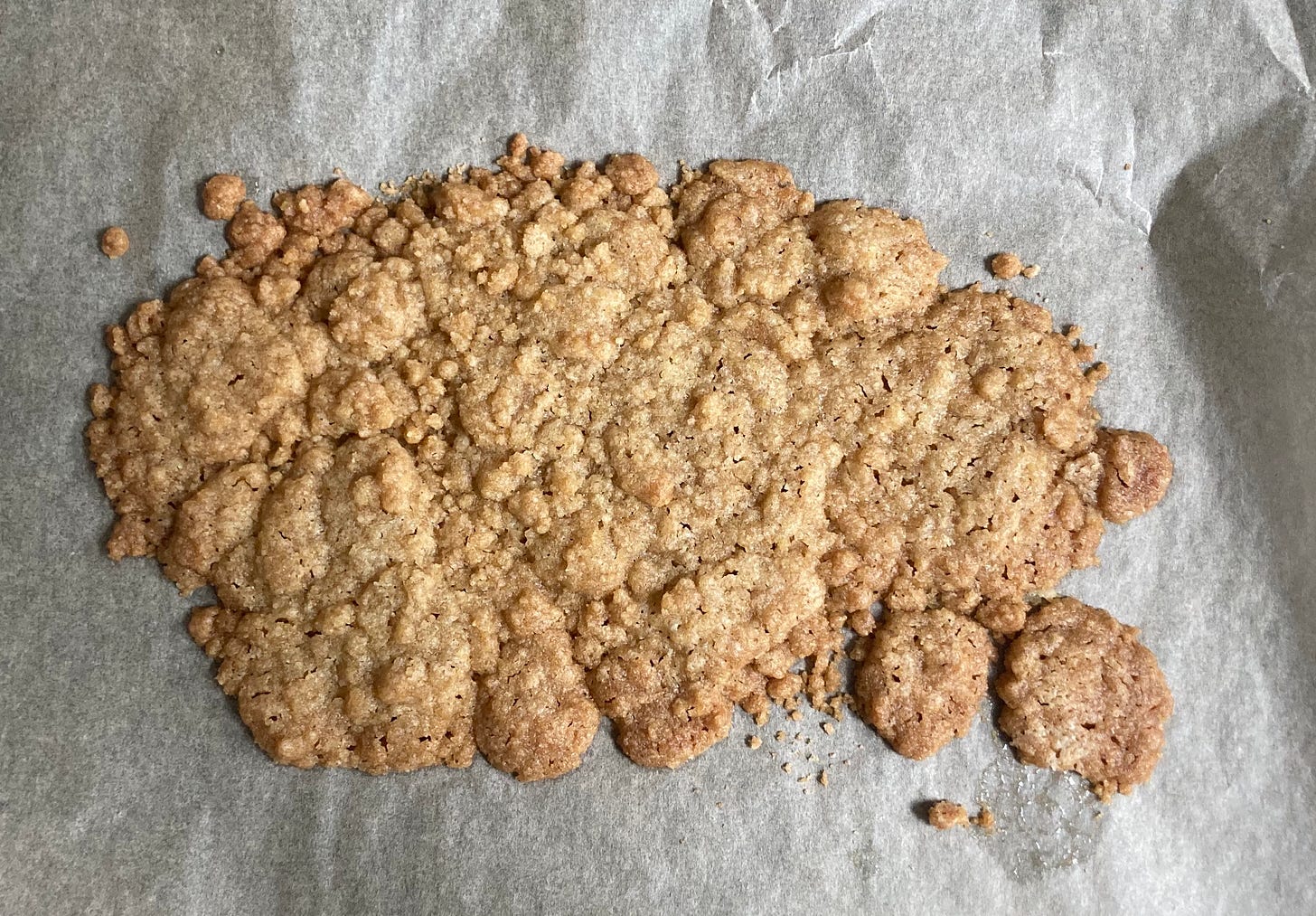
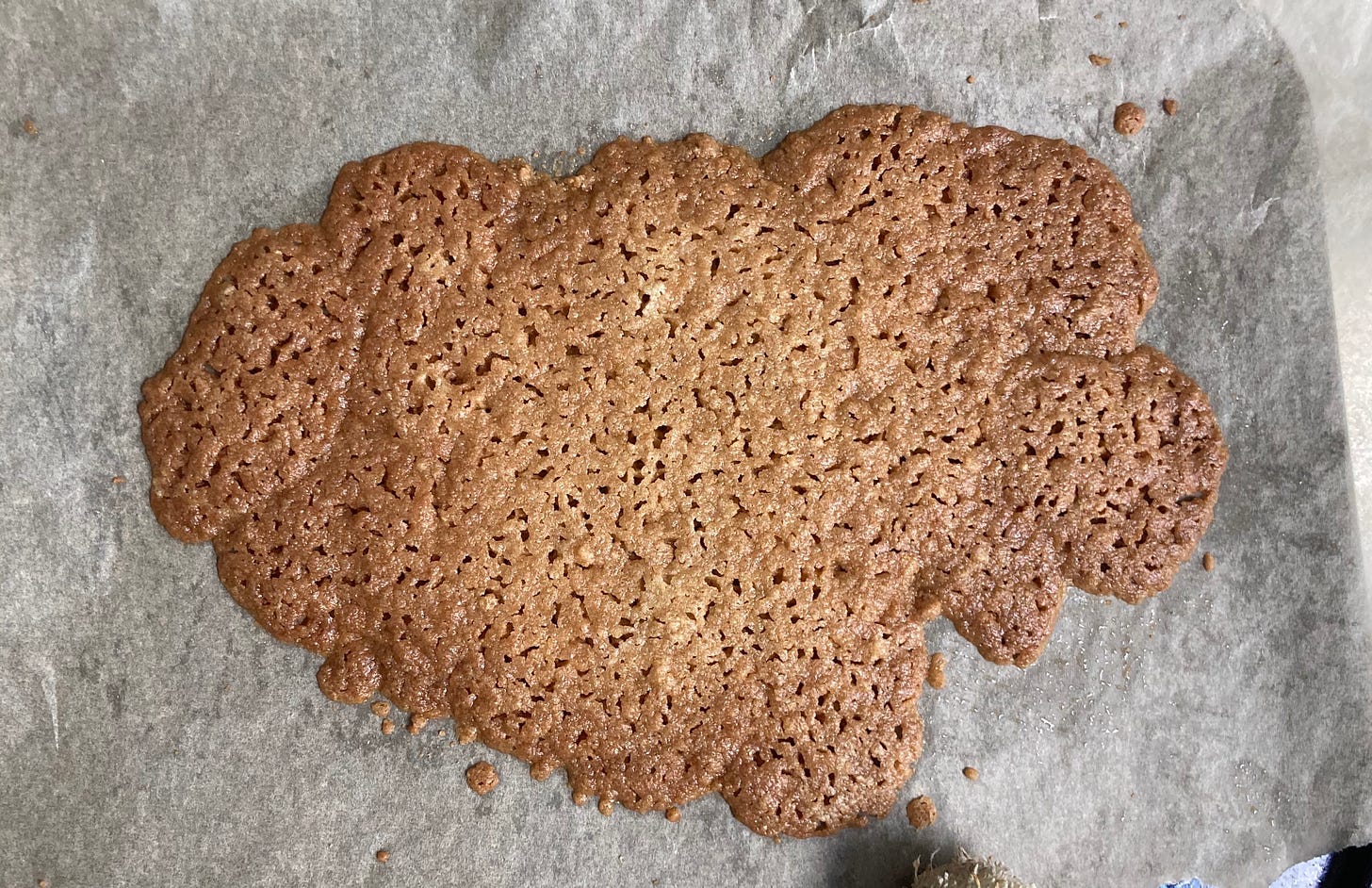
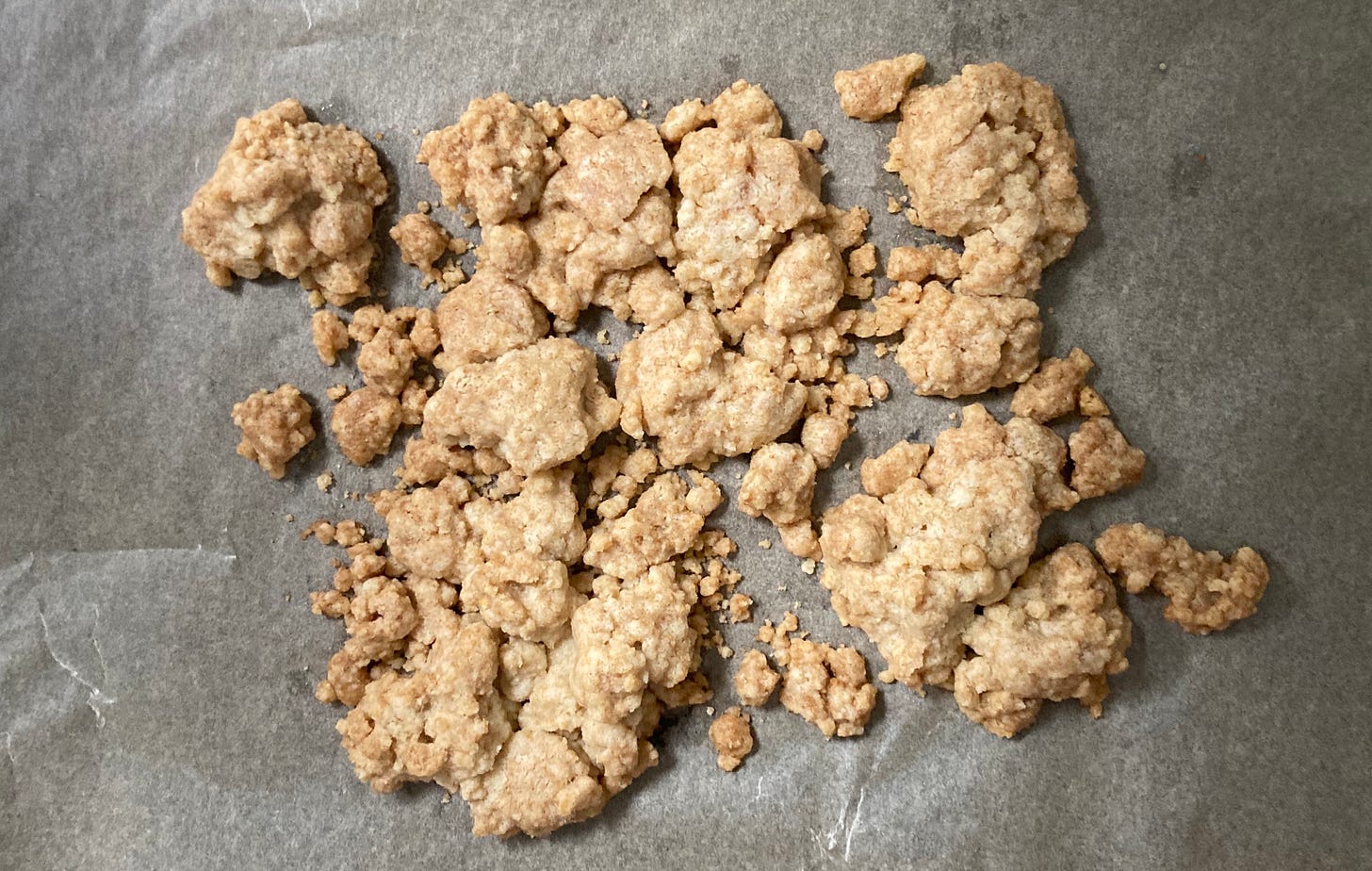
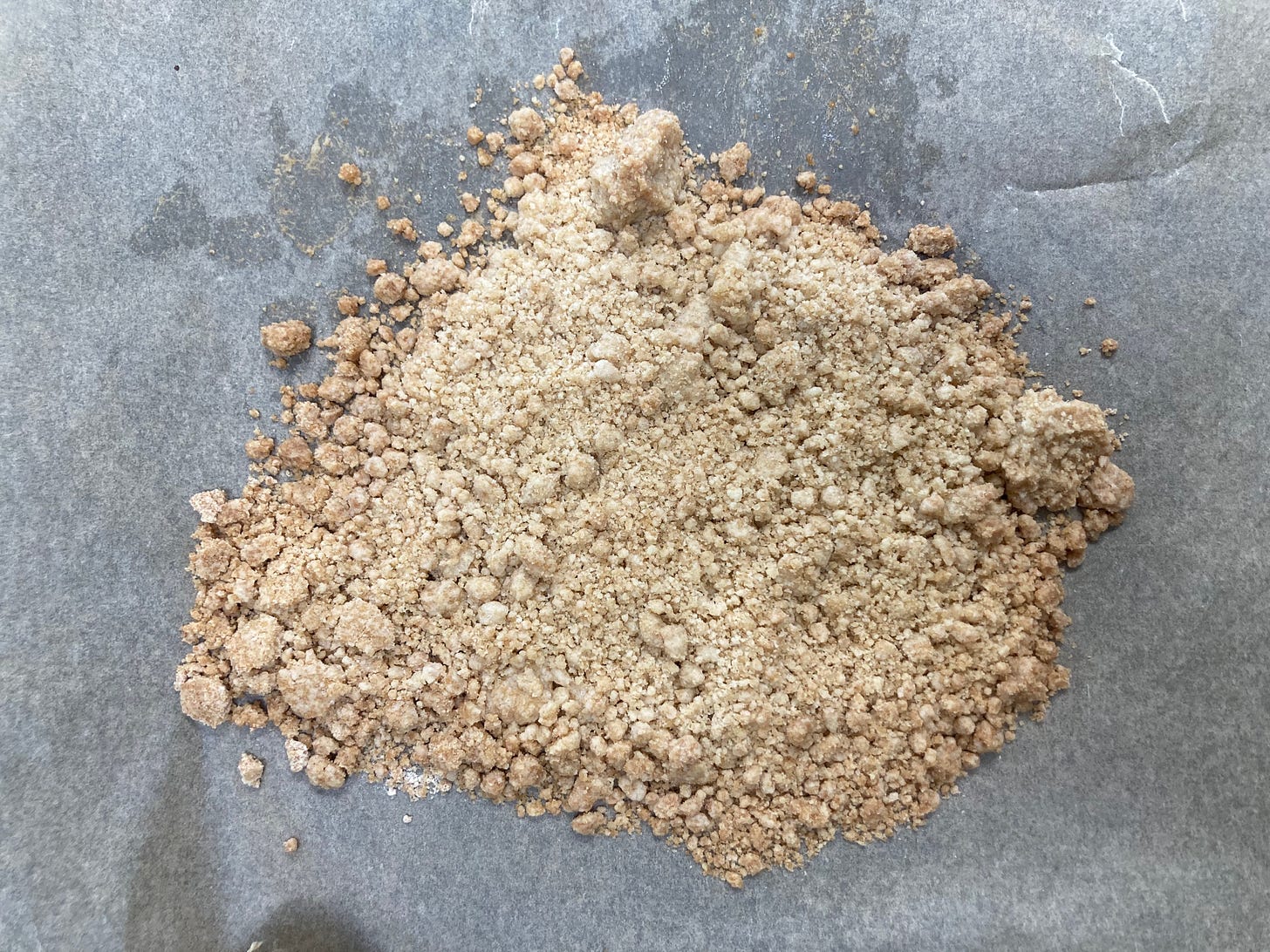
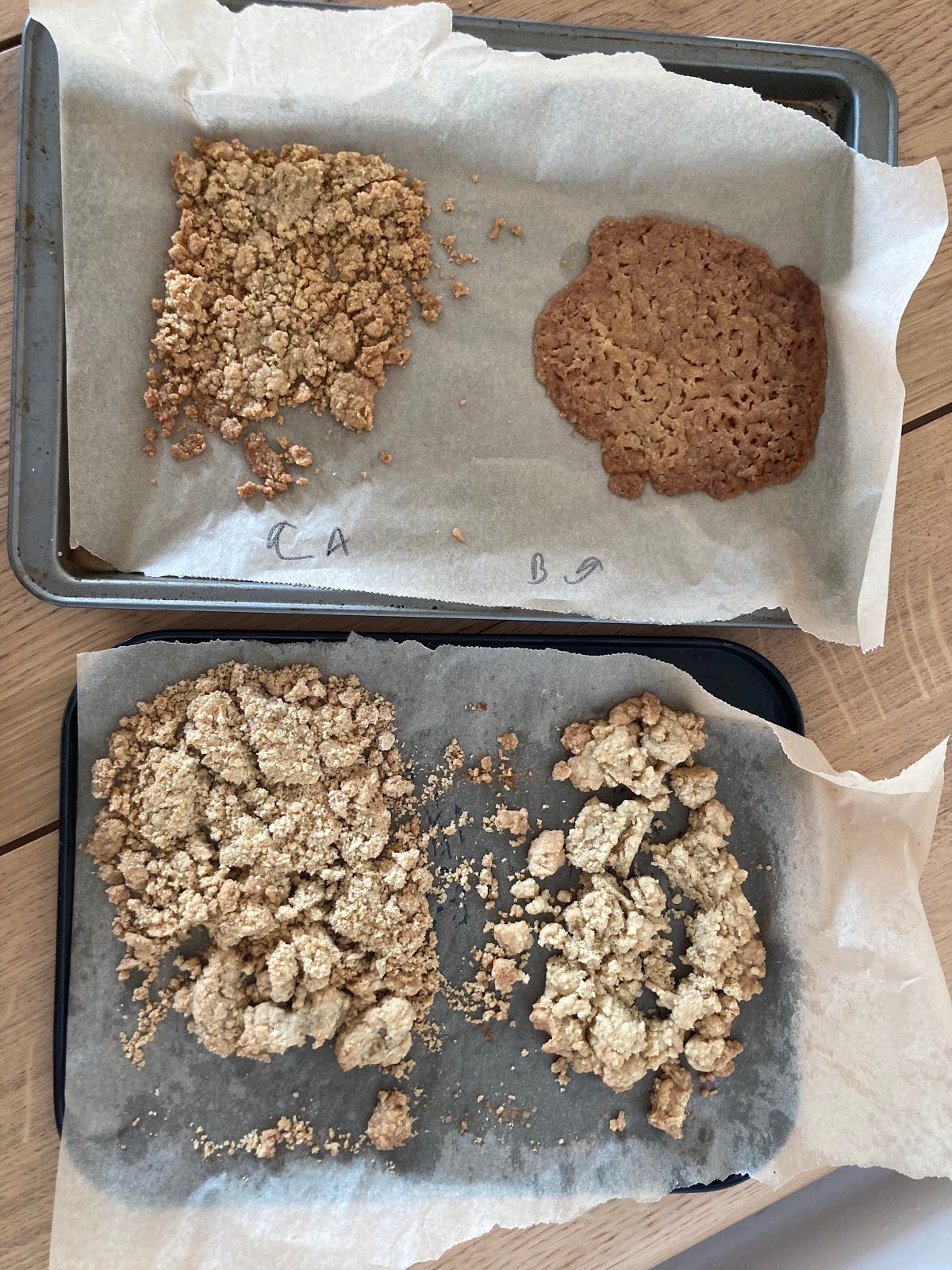
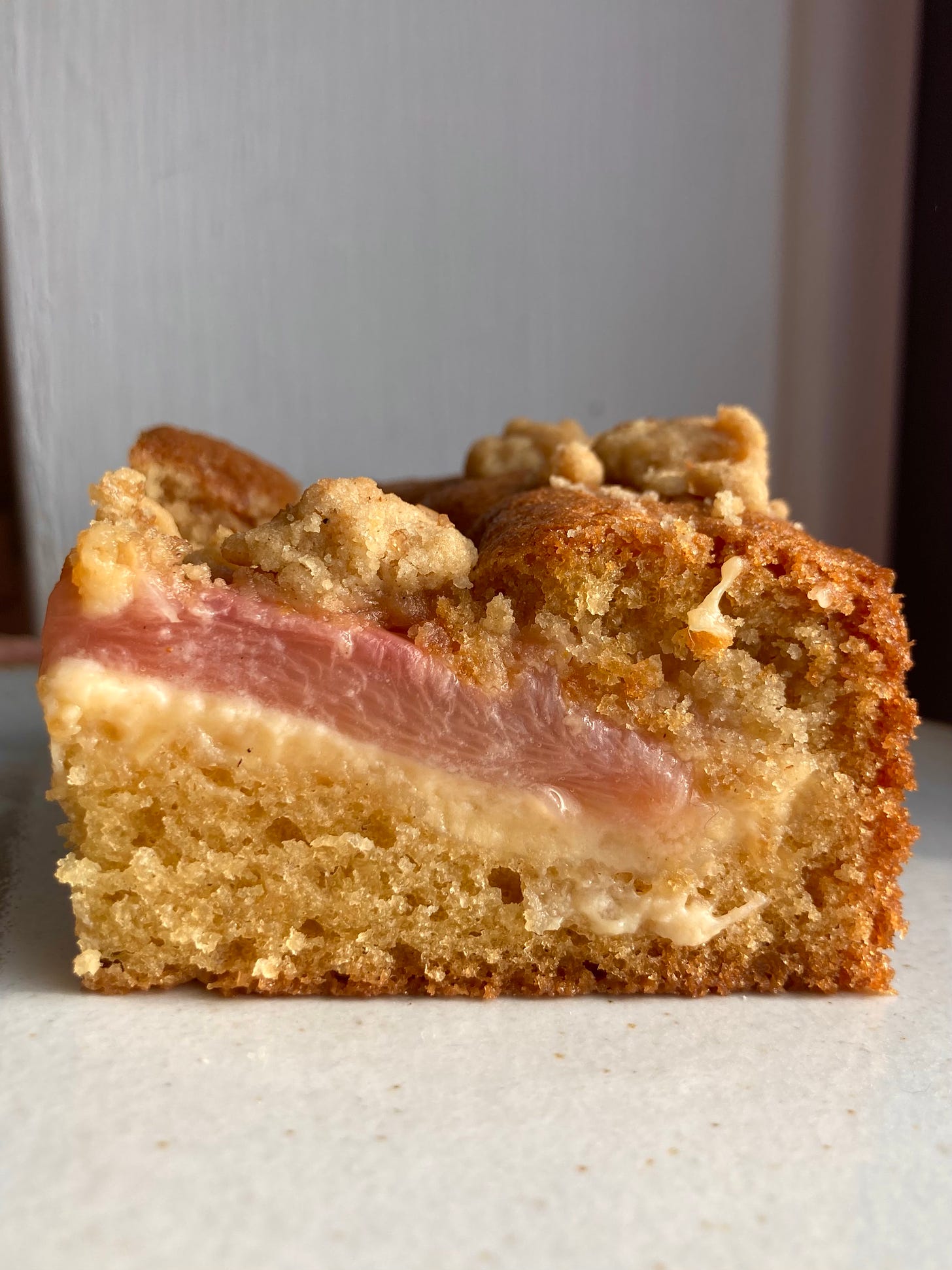
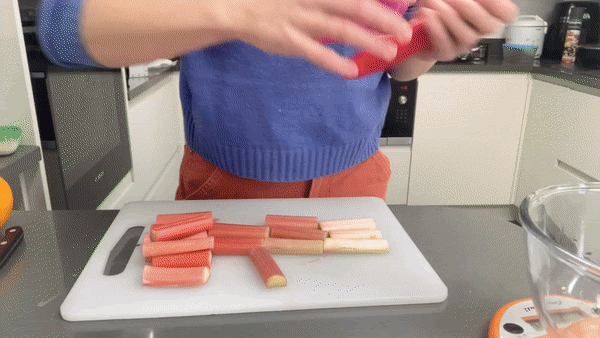
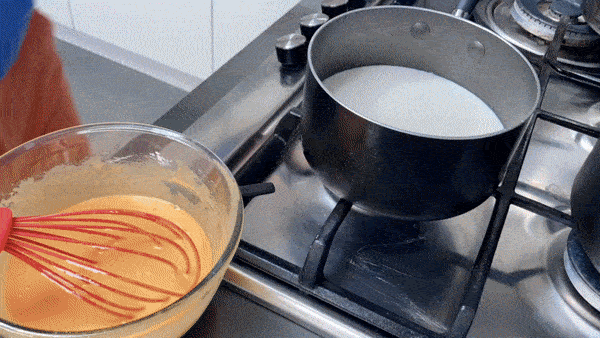
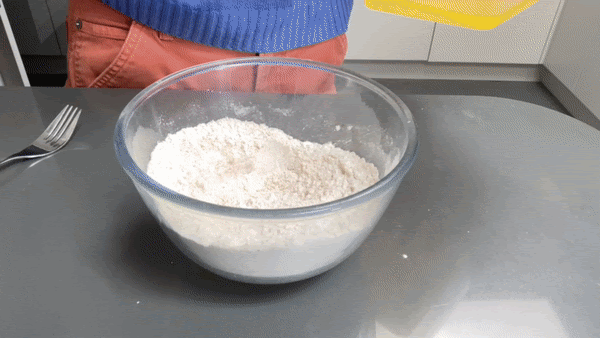

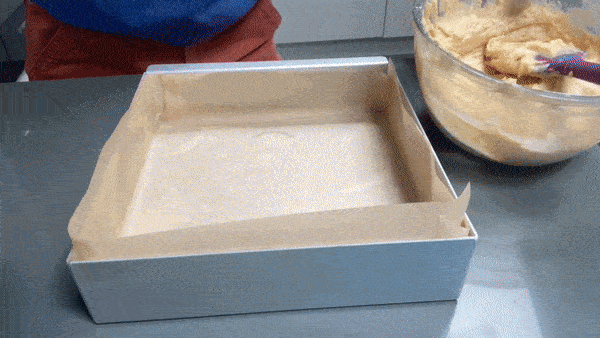
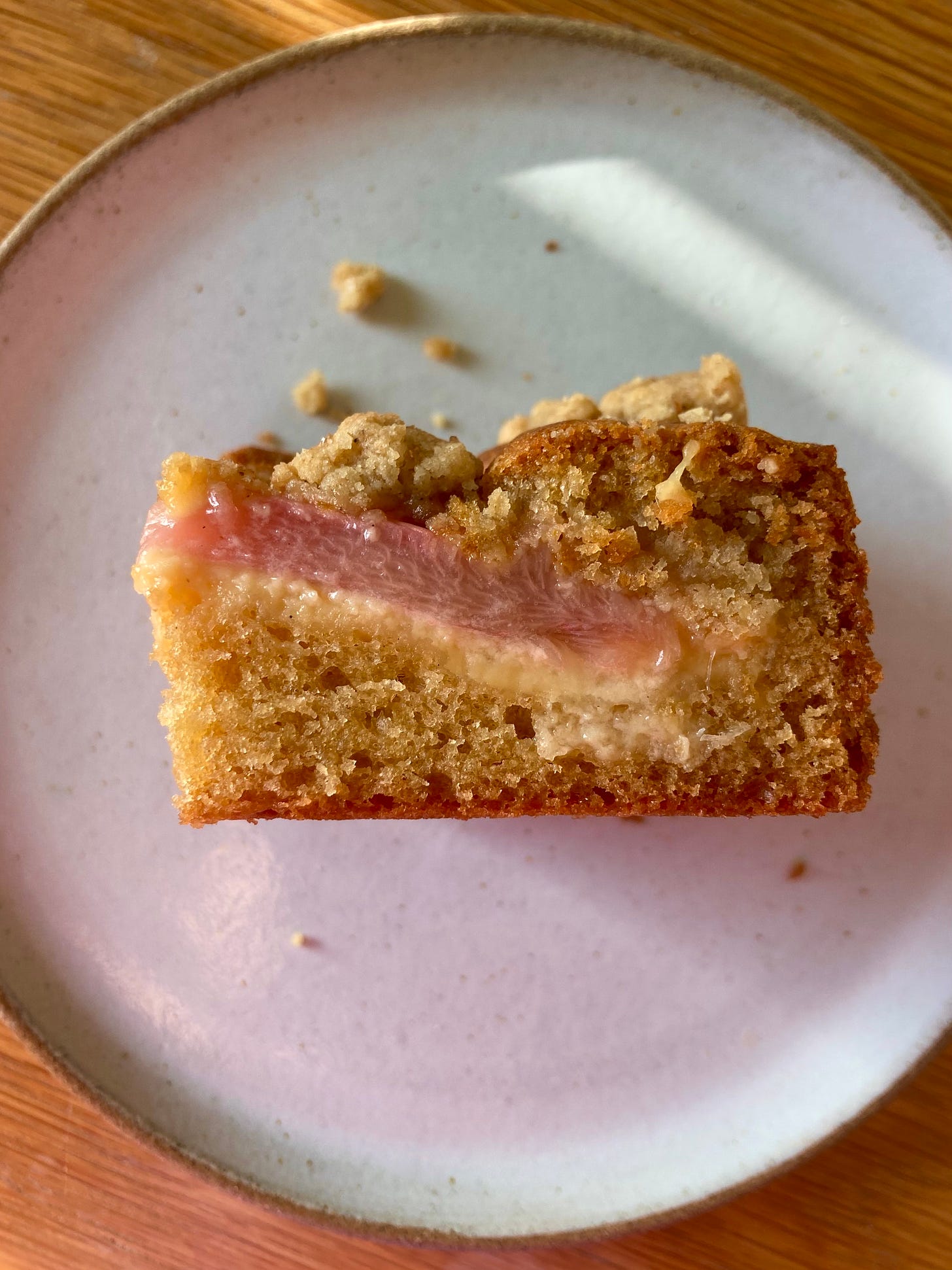
Nicola I made this on Saturday with lighted stewed cooking apples instead - it was DIVINE . When I’m allowed to go home to my parents I am 100% making them this !
Hi all, if using self raising flour would you take out baking powder and bicarb entirely?